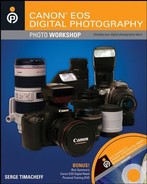5.1. GHOSTING
Pointing a camera and lens toward a bright light of any kind can produce ghosting, which has two prominent features: an area of overexposure that is completely white and a part of the image that is streaked and patterned. It is caused by strong light reflecting from the image sensor back to the lens of your camera, and can also occur with inexpensive filters or smudged, unclean optical surfaces. While less expensive lenses, those with lesser-quality multicoatings and optics, suffer from this effect more than better-quality lenses, it can happen with any lens given the right conditions and a strong-enough light source. The reason it's called ghosting is because often the effect produces almost a figure-like shape that is partially, if not completely, transparent, and more than a few people have confused optical ghosting for a real apparition.
Another reason for its name is that ghosting tends to occur more frequently in night shots where there is a lot of contrast between a light source and the rest of the image. It also happens more commonly when you're using a telephoto lens with an add-on lens component, such as a UV or haze filter.
Moving the light source, using a lens hood, and shielding the light are all possible solutions for eradicating ghosting in your photos. Using one of Canon's large diameter Image Stabilizing (IS) ultra-telephoto lenses, which have a meniscus lens element (which is shell-shaped and has two spherical, curved sides, convex and concave), can also greatly reduce the problem of ghosting.
